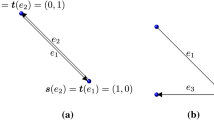Abstract
Entropy production rate (EPR) is the fundamental theoretical quantity in non-equilibrium thermodynamics whereas reaction rate is the primary experimental quantity for a chemical system out-of-equilibrium. In this work, we explore a connection between the above two quantities for general reaction networks. Both cyclic and linear networks of arbitrary dimension are studied, along with a mixed variety. The systems can attain a non-equilibrium steady state (NESS) under chemiostatic condition, which becomes the state of true thermodynamic equilibrium when detailed balance holds. We show that there exists a universal functional relationship of the EPR with reaction rate close to steady states for all the networks considered. Near a NESS, the former varies linearly with the reaction rate. On the other hand, around a true equilibrium, it varies quadratically with the latter. Numerical experiments justify our analytical findings quite transparently.








Similar content being viewed by others
References
P. Miskinis, J. Math. Chem. 51, 914 (2013)
B. Boros, J. Math. Chem. 51, 2455 (2013)
H.J. Hwang, J.J.L. Velazquez. J. Math. Chem. 51, 1343 (2013); ibid. 51, 2074 (2013).
C.H. Lee, K.D. Park, B. Jang, J. Math. Chem. 51, 1945 (2013)
S.R. de Groot, P. Mazur, Non-equilibrium Thermodynamics (North-Holland, Amsterdam, 1962)
G. Nicolis, I. Prigogine, Self-organization in Non-equilibrium Systems (from Dissipative Structures to order through Fluctuations), (John Wiley and Sons, New York, 1977)
J. Schnakenberg, Rev. Mod. Phys. 48, 571 (1976)
D. Andrieux, P. Gaspard, J. Chem. Phys. 121, 6167 (2004)
P. Gaspard, J. Chem. Phys. 120, 8898 (2004)
H. Qian, D.A. Beard, Biophys. Chem. 114, 213 (2005)
H. Qian, E.L. Elson, Biophys. Chem 101, 565 (2002)
X.J. Zhang, H. Qian, M. Qian, Phys. Rep. 510, 87 (2012)
D.Q. Jiang, M. Qian, M.P. Qian, Mathematical Theory of Nonequilibrium Steady States. Lect. Notes Math., Vol. 1833, (Springer, New York, 2004)
K. Banerjee, B. Das, G. Gangopadhyay, J. Chem. Phys. 136, 154502 (2012)
W. Min, L. Jiang, J. Yu, S.C. Kou, H. Qian, X.S. Xie, Nano Lett. 5, 2373 (2005)
H. Qian, Annu. Rev. Phys. Chem. 58, 113 (2007)
Acknowledgments
K. Banerjee acknowledges the University Grants Commission (UGC), India for Dr. D. S. Kothari Fellowship.
Author information
Authors and Affiliations
Corresponding author
Rights and permissions
About this article
Cite this article
Banerjee, K., Bhattacharyya, K. Entropy production as a universal functional of reaction rate: chemical networks close to steady states. J Math Chem 52, 820–832 (2014). https://doi.org/10.1007/s10910-013-0295-8
Received:
Accepted:
Published:
Issue Date:
DOI: https://doi.org/10.1007/s10910-013-0295-8



